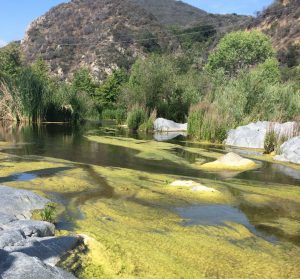Macroalgal work being used to draft updated nutrient TMDL for Santa Margarita River Estuary

A SCCWRP-led investigation into how to set scientifically defensible macroalgal biomass and nutrient loading targets in the Santa Margarita River Estuary is serving as the basis of a proposed alternative nutrient TMDL (total maximum daily load) for the estuary.
San Diego Regional Water Quality Control Board staff will recommend board approval this fall of a set of numeric nutrient targets designed to reduce the proliferation of macroalgal blooms in the northern San Diego County estuary. The macroalgae numeric endpoints and related nutrient loading targets are based on work conducted by
SCCWRP and its partners over the past few years; they would replace outdated total nitrogen (TN) and total phosphorous (TP) numeric targets for the estuary.
The Santa Margarita River Estuary alternative nutrient TMDL represents the first application of SCCWRP’s macroalgal assessment framework to a California coastal estuary dominated by macroalgal blooms. Previous TMDLs and restoration discussions in other Southern California estuaries, however, have relied on the supporting science.
Because macroalgae are the most abundant type of algae in Southern California estuaries, the example set by the Santa Margarita TMDL is expected to influence how nutrient management is approached in other macroalgae-dominated estuaries going forward.
Researchers are now moving upstream of the Santa Margarita River Estuary to study nutrient loading in the river’s main stem. This work will provide opportunities to test-drive elements of a proposed State Water Board stream biointegrity and biostimulatory policy, which could be adopted as early as 2019 to govern the health of wadeable streams.
More news related to: Eutrophication, Harmful Algal Blooms